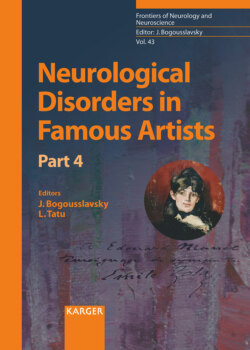Читать книгу Neurological Disorders in Famous Artists - Part 4 - Группа авторов - Страница 30
На сайте Литреса книга снята с продажи.
The Mythology of Trepanation
ОглавлениеNo reference to a violent head trauma or to trepanation is present in the letters written by Céline or his family during the First World War, nor in Céline’s medical and military records. Céline made this legend up himself, which was first revealed by Jean Ducourneau in 1966 and has been confirmed since then by several authors [Ducourneau, 1966; Gibault, 1985, pp. 157–164; Roynette, 2015].
This legend was useful in the context of the interwar period to help him become recognised as a writer. Robert Denoël (1902–1945), the publisher of his first novel Voyage au bout de la nuit (Journey to the End of the Night), seemed to support this idea. The myth of trepanation was part of a larger rewriting of his First World War years aimed at presenting himself as a brave French soldier. He used this virtuous image when he was accused and tried for collaborationism after the Second World War.
The diffusion of the trepanation legend was very efficient. Upon publication of Voyage au bout de la nuit (Journey to the End of the Night), Louis-Ferdinand Destouches, an unknown writer, chose his mother’s and grandmother’s first name Céline as a pen-name. He detailed his glorious war and his medical troubles to the journalists and focused on his trepanation. In 1933, he explained: “I was trepanned, much good it did me! I still hurt […] Head and left eye” [Pollet, 1956, p. 34]. Some writers believed the trepanation. In 1948, Milton Hindus (1916–1998) wrote: “Where he has been trepanned, he wears a steel band which causes all sorts of noises in his head” [Hindus, 1969, p. 35]. The writer Marcel Aymé (1902–1967) and Prof. Henri Mondor (1885–1962) also claimed this trepanation. A photograph of Céline with a bandage around his head, Milon and two other wounded soldiers in the Val-de-Grâce hospital gardens was frequently misinterpreted as formal evidence of Céline’s trepanation (Fig. 4). The location of the bandage is rather evocative of a dental or ear problem.
Another part of his First World War rewriting was the drawing published in L’Illustré national in November 1915, 1 year after he was awarded the Médaille militaire. This illustration, accompanied by the official text of the citation of the medal, depicts a mounted soldier riding in the countryside between explosions (Fig. 5). The picture does not correspond to the real circumstances of Céline’s wound. As noticed by many authors, the artist transformed a dangerous course on foot between the trenches into a glorious dash on horseback [Godard, 2011; Richard, 2009; Roynette, 2015]. Obviously, Céline was not the instigator of this patriotic drawing but he used this publication to highlight his own courage on the battlefield, in particular after the Second World War. This illustration was also used in the advertising campaign for the publication of D’un château à l’autre (Castle to Castle).
Fig. 4. Louis Ferdinand Destouches with his head bandage in the Val-de-Grâce Hospital (Paris) in 1914 (public domain).
Céline’s First World War history reveals another inconsistency. Written by another hand, the evocation of a mixed wound by sabre and bullet appears in his military record. None of the medical reports discussed a sabre wound. It is unclear why this mention was added to the military report but it might be linked to the picture of the typical fighting cavalry man published in L’Illustré national.
Marcel Brochard, a close friend during Céline’s stay in Rennes for his medical studies between 1918 and 1922, summarised the trepanation myth after his friend’s death as such: “At last Louis, old soldier, will you tell us the truth on your famed trepanation. They all believed you of course, you the trepanned man from the battles of August 1914, with your poor hammered brain; even Henri Mondor, Professor, though a professional, repeats over and over again that your skull was broken […] We, your mates from Rennes, know very well that your head has never been wounded nor trepanned” [Brochard, 2007].
Fig. 5. L’Illustré national, No. 52, November — December 1915 (private collection).
